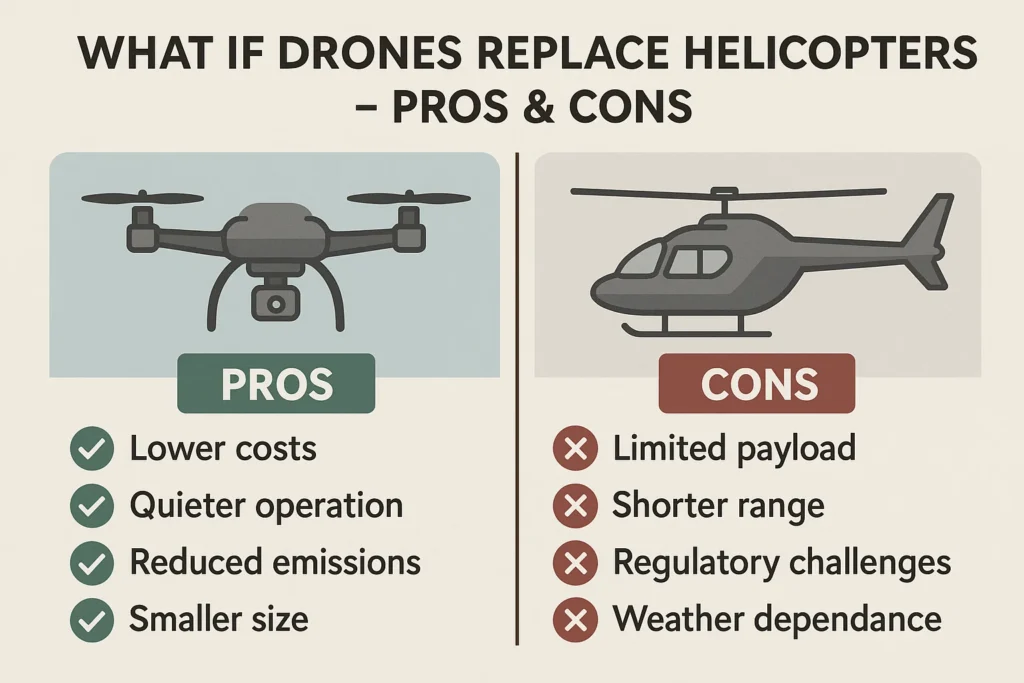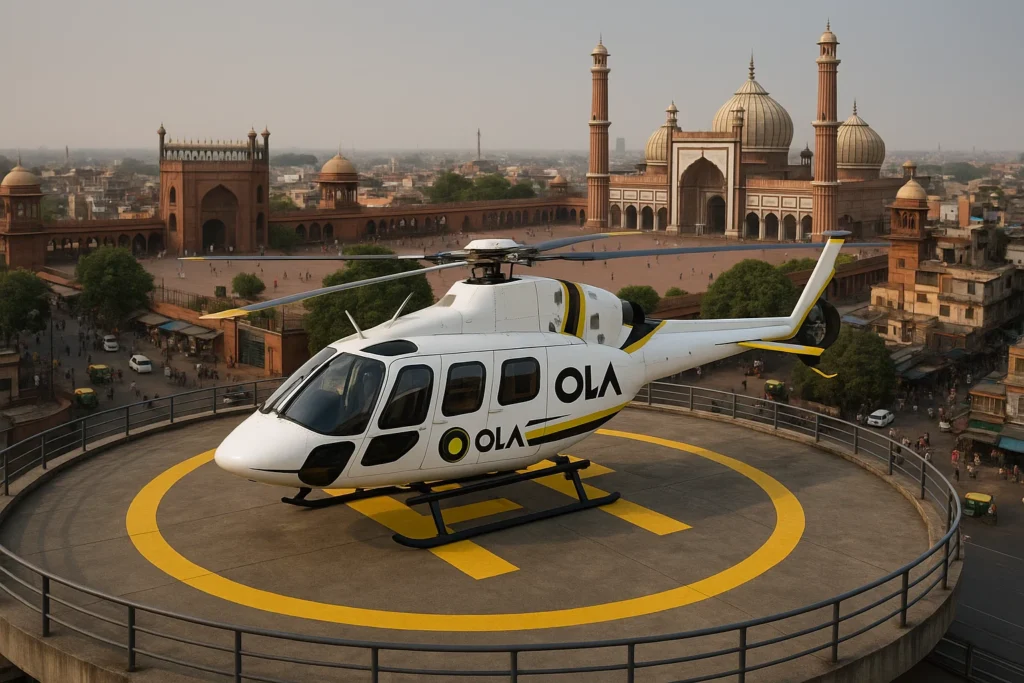✨ Introduction: What If Drones Replace Helicopters?
The idea of drones replacing helicopters is no longer a far-off futuristic fantasy. With the rapid advancement in drone technology, it’s a question that’s starting to become more relevant, especially in the fields of aerial transport, logistics, and emergency services. But what would this shift look like, and how would it affect the world of helicopter travel as we know it?
In this blog post, we’ll dive into the pros and cons of drones replacing helicopters, looking at their potential advantages and the challenges they may bring. Could drones truly be the future of aerial travel, or are there aspects where helicopters will always hold the edge?
🚁 1. Pros of Drones Replacing Helicopters
🌍 Overview:
While helicopters have long been the go-to option for many aerial services, drones bring a host of benefits that could make them a viable alternative in several industries. Let’s explore the pros of drones taking over roles traditionally held by helicopters.
✨ Highlights:
💰 Lower Costs for Aerial Services
-
Drones are cheaper to operate than helicopters due to their lower fuel consumption, minimal maintenance needs, and no need for a pilot in many cases. This makes them more affordable for certain services like aerial photography, delivery services, and small-scale passenger transport.
🌱 Environmental Impact
-
Drones are more eco-friendly than helicopters, as many models are powered by electricity instead of fossil fuels, leading to lower carbon emissions and a reduced environmental footprint.
🚀 Increased Efficiency
-
Drones can be more efficient in certain applications, such as quick deliveries and emergency services, because they don’t require runways or helipads and can take off and land in tight spaces with minimal infrastructure.
🏙️ Access to Hard-to-Reach Areas
-
Drones are smaller and more agile, making them perfect for accessing areas that might be too small or difficult for helicopters to navigate, such as remote locations, rural areas, or narrow city streets.
-
Booking Link: Book Your Drone Service
🌍 2. Cons of Drones Replacing Helicopters
🚧 Overview:
While drones offer a variety of benefits, they also come with some significant limitations that may prevent them from fully replacing helicopters in all aspects of aerial travel and service. Let’s look at the cons of relying on drones as a primary aerial transportation method.
✨ Highlights:
✈️ Limited Payload Capacity
-
Unlike helicopters, which can carry large payloads such as people, medical supplies, and equipment, most drones have limited carrying capacity. This makes them unsuitable for many applications where helicopters excel, such as heavy lifting, medical airlifts, and large-scale cargo transportation.
🌩️ Weather Sensitivity
-
Drones are more sensitive to weather conditions than helicopters, especially in high winds, rain, or storms. Helicopters can still fly in challenging weather, whereas drones may have difficulty flying in adverse conditions, affecting their reliability.
🚀 Technological Limitations
-
While drones are advanced, they are still subject to battery life limitations. They typically require frequent recharging or battery swaps, which restricts their operational time compared to helicopters. Helicopters can fly for hours without needing a break.
🔒 Security Concerns
-
Drones are more vulnerable to hacking, interference, or being shot down, posing a security risk in sensitive or high-risk areas. Helicopters, on the other hand, are typically more secure and protected against such vulnerabilities.
🏙️ Air Traffic and Regulations
-
As the use of drones grows, managing drone traffic in busy urban areas could become challenging. Regulatory bodies, such as the DGCA (Directorate General of Civil Aviation) in India, will need to enforce airspace management and safety standards, which could create complexities for urban drone mobility.
-
Booking Link: Explore Helicopter Services for Large Loads
🌍 3. Can Drones Replace Helicopters in All Areas?
🏙️ Overview:
While drones have undeniable potential, they are unlikely to fully replace helicopters in every scenario. Certain helicopter applications—especially those requiring heavy lifting, longer flight times, or the need for pilots—will still need to rely on traditional helicopters for the foreseeable future.
✨ Highlights:
🌍 Tourism and Sightseeing
-
While drones can offer scenic aerial shots, they are not yet capable of replacing the full tourist experience that a helicopter can provide. Helicopter tours allow passengers to enjoy expansive views, comfortable seating, and personalized service that drones cannot match.
🚁 Emergency Medical Services
-
Drones are unlikely to replace helicopter air ambulances in critical medical emergencies. Helicopters can carry large medical equipment, multiple patients, and a medical team, whereas drones can only handle smaller payloads.
🚧 Heavy Lifting and Cargo Transport
-
For heavy lifting and large-scale cargo transport, helicopters are still the best option. Drones simply don’t have the capacity to lift and transport large or bulky items, such as construction materials or industrial equipment.
🌍 4. The Future of Helicopters and Drones: A Synergy?
🚁 Overview:
Rather than one completely replacing the other, helicopters and drones may end up working in synergy. Drones can handle short-distance, lightweight tasks, such as aerial photography, small deliveries, and scouting, while helicopters continue to excel in longer flights, heavy-duty operations, and emergency services.
✨ Highlights:
-
Helicopters and drones may complement each other in fields like delivery services, logistics, and urban mobility.
-
The development of electric drones could reduce their environmental impact, making them more viable for future applications.
-
Urban air mobility could involve both helicopters and drones working together for efficient transportation and service delivery.
-
Booking Link: Book Helicopter and Drone Services
🌍 Conclusion: What If Drones Replace Helicopters – Pros & Cons
While drones offer several advantages, such as cost savings, environmental benefits, and increased efficiency in certain applications, they still have limitations in payload capacity, weather resistance, and operational time. Helicopters, on the other hand, continue to excel in heavy-duty operations, medical airlifts, and luxury travel.
The future may not involve one completely replacing the other but rather a collaborative ecosystem where both drones and helicopters have their own distinct roles in urban mobility and transportation services.
Ready to experience the best of helicopter travel? Book a helicopter ride with DreamSafar and explore the skies today!
🔗 Useful Links:
Resources:
❓ FAQ Section:
Q1: Can drones fully replace helicopters for air ambulances?
A1: No, drones are currently unable to carry multiple patients and medical staff along with necessary medical equipment. Helicopters are still the preferred option for air ambulance services.
Q2: What are the limitations of drones compared to helicopters?
A2: Drones have limited payload capacity, are more susceptible to weather changes, and have shorter battery life compared to helicopters. Helicopters are better suited for heavy-duty operations and longer distances.
Q3: Will drones be used for aerial tourism in the future?
A3: While drones can provide aerial photography and short scenic views, they are unlikely to replace the luxury and comfort of helicopter tours, which offer greater views and longer flights.


